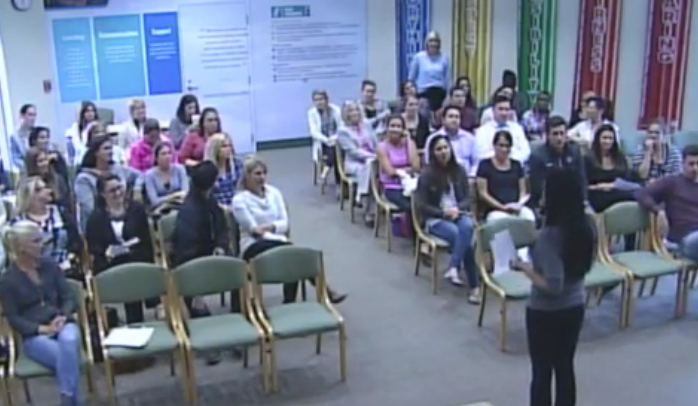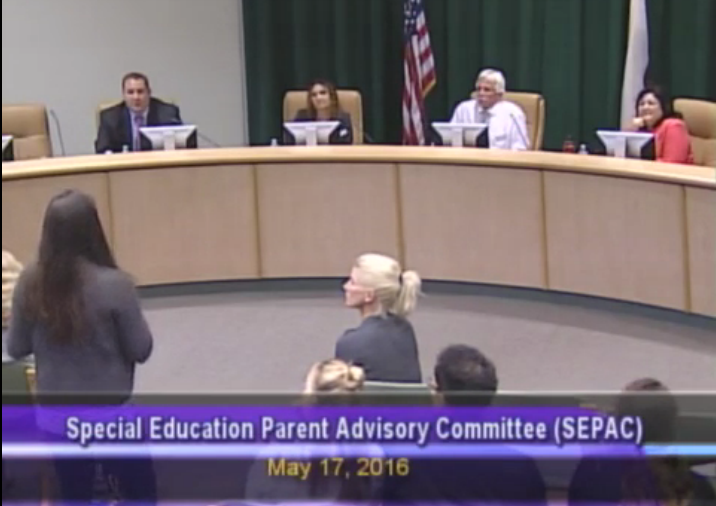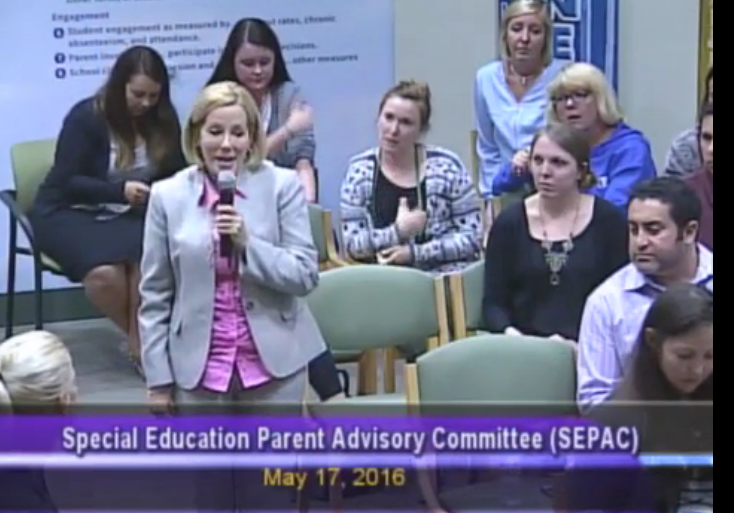
Compassion, unity, and professionalism emanated at the SEPAC (Special Education Parents Advisory Committee) “Let’s Talk About Inclusion” panel discussion held at CUSD Board Room on Tuesday, May 17.
 Co-presidents of SEPAC, Rita Alipour and Faith Peterson, ran a well-organized two-part meeting. The first part consisted of formal prepared questions posed by Ms. Alipour to a panel of experts in the field of Special Education. The second part of the meeting, moderated by Ms. Petersen, was a more informal series of questions-and-comments section initiated by Coronado school parents, educators, and administrators.
Co-presidents of SEPAC, Rita Alipour and Faith Peterson, ran a well-organized two-part meeting. The first part consisted of formal prepared questions posed by Ms. Alipour to a panel of experts in the field of Special Education. The second part of the meeting, moderated by Ms. Petersen, was a more informal series of questions-and-comments section initiated by Coronado school parents, educators, and administrators.
The stated topic of the meeting was the Inclusion method of classroom instruction that was introduced into the kindergarten classrooms at Village Elementary this past school year and will be expanded into the first and second grade classrooms next year. The third grade classrooms will then be included the following year.
Inclusion is a method of instruction that fully includes our special needs students into a general education classroom.
This year’s experience with the Inclusion model generated concerns from both general education parents and special needs parents.

While the terms are often used interchangeably, “Mainstreaming” and “Inclusion” are two different methods of integrating special needs students into the classroom.
Mainstreaming is when special needs students are invited into a regular classroom room for a limited part of the day. In the mainstreaming model, these special needs students might be brought in for an art class or a special reading program, but their primary classroom would be the special education classroom. The special education teacher retains full responsibility for that student. Matters such as roll taking, the issuing of reports, etc. is done by the special education teacher in the special education classroom.
In an Inclusion model, the special needs student is a full-time member of the general classroom. The general education teacher has primary responsibility for the special needs students, just as he or she does for the general needs student. The general education teacher includes all students in the roll, etc.
With the Inclusion model, special education teachers, paraprofessionals, or other specialists attend the regular classroom to support the special education student.
The guest panelists at Tuesday’s meeting unanimously touted the benefits of the Inclusion method for both the special education students and the general education students.
Some of the benefits for special education students were increased verbal ability, increased social ability, and emotional well-being. Special education students were also better equipped to deal with the real world outside of the school setting, because they weren’t sequestered into a special education classroom all day.
General education students also benefited greatly from the Inclusion model. Research has shown that these students gained increased empathy and tolerance immediately and for later in life. Students who volunteered to be peer-tutors to special education students saw their own academic grades improve through teaching subjects to the special education students. Higher numbers of these volunteer peer tutors found servicing special education as a career vocation.
It should be emphasized that both the general education parents and the special needs parents fiercely supported each other. In fact, as in the case of Ms. Alipour, some parents had both special needs students and general education students.

It was on the topic of “Clustering” special-needs students that brought all parents together to ask some tough questions of the panel and the Village Elementary Principal Whitney De Santis. Clustering is when a larger portion of the special-needs students are placed in one classroom rather than spread across many classrooms.
Mrs. DeSantis, after thanking the school staff, acknowledged that in this first year, the “model isn’t perfect.” However, she also sought to correct a misconception that the kindergarten class was a cluster classroom: “that’s a misnomer.” Mrs. DeSantis emphasized that “we welcome parent input…and my door is always open.”
This is what happened in this year’s kindergarten class. By all accounts (parents and administrators) the ratio of special needs students to general education students was somewhat high to too high. This isn’t to say that there wasn’t plenty of support for the students, but as one parent pointed out, “The classroom was just very busy: special needs students, general education students, specialists for each of the special needs students, and the regular classroom teacher.” Volunteer parents in the classroom felt it was just too busy for learning.
When the parents asked the expert panel if it was best practice to cluster all the special needs students in one general education classroom, rather than put a few special needs students into multiple classrooms, the answer implied was “no.” “Implied no” because the experts were careful to note that they were speaking generally about the Inclusion method of teaching, rather than exactly about what was happening at Coronado schools.
One explanation by a panel member was that while there is no perfect formula (due to skills of a particular teacher or needs of a particular student), a 1/3 special needs student ratio to 2/3 general education students might be appropriate.

Richard Erhard explained that the Coronado best practice model with moderate to severe special needs children is 1/3 to 1/4 of the classroom being special education students, if in fact they are [well] supported. He did acknowledge that the kindergarten classroom that people have been concerned about is at a higher ratio.
In the meeting, and in talking with parents off the record, it seemed that parents felt that the motivation for clustering was financial: that it is less expensive for the district to cluster the special needs students in one classroom, rather than hire many special needs specialists and spread them across the various classrooms.
So while it seemed all supported the Inclusion model, the disagreement was on how best to implement Inclusion with the financial resources available.

No one there thought Mrs. DeSantis wanted anything less than the best for the Village Elementary students, but they did want Mrs. DeSantis to understand how very important it was to them that the kindergarten classrooms had a positive classroom learning environment for all.
It should be noted that the Coronado Village administration had no prior conversation with the panel and made themselves very available to the parents at the event.
Mrs. DeSantis explained that in the 2016-2017 school year, there will be two first grade and two second grade inclusion classrooms. She assured those in attendance that these classrooms would be calm environments providing meaningful, effective instruction for all students.
The most important take away is that SEPAC is not just for parents of special needs students. SEPAC is parents of general education students and parents of special needs students coming together and working collaboratively with each other and the school to make education best for every child.
SEPAC has an informal gathering scheduled for June 2 at Candelas. This is a great opportunity for parents to talk with each other, with administrators, and with teachers while enjoying snacks or beverages. All are welcome!
You can contact SEPAC at their email: [email protected] or find them on their facebook group.




